NSB202 Assignment: Wellbeing of Aboriginal People and Cultural Safety
VerifiedAdded on 2023/04/20
|9
|2601
|497
Essay
AI Summary
This essay explores the wellbeing of Aboriginal people in Australia, focusing on the impact of racism, both individual and institutional, within the healthcare system. It defines cultural competency and cultural safety, emphasizing the need for healthcare professionals to be culturally safe practitioners. The essay highlights the historical and political factors that have influenced Aboriginal health, including past discriminatory policies. It discusses the role of nurses in bridging health gaps and building therapeutic relationships, while also acknowledging the challenges faced by Aboriginal people in accessing healthcare due to discrimination. The essay concludes with the student's reflections on the readings, expressing a commitment to implementing culturally safe practices in future healthcare delivery, building trust with patients, and advocating for equitable access to health services.
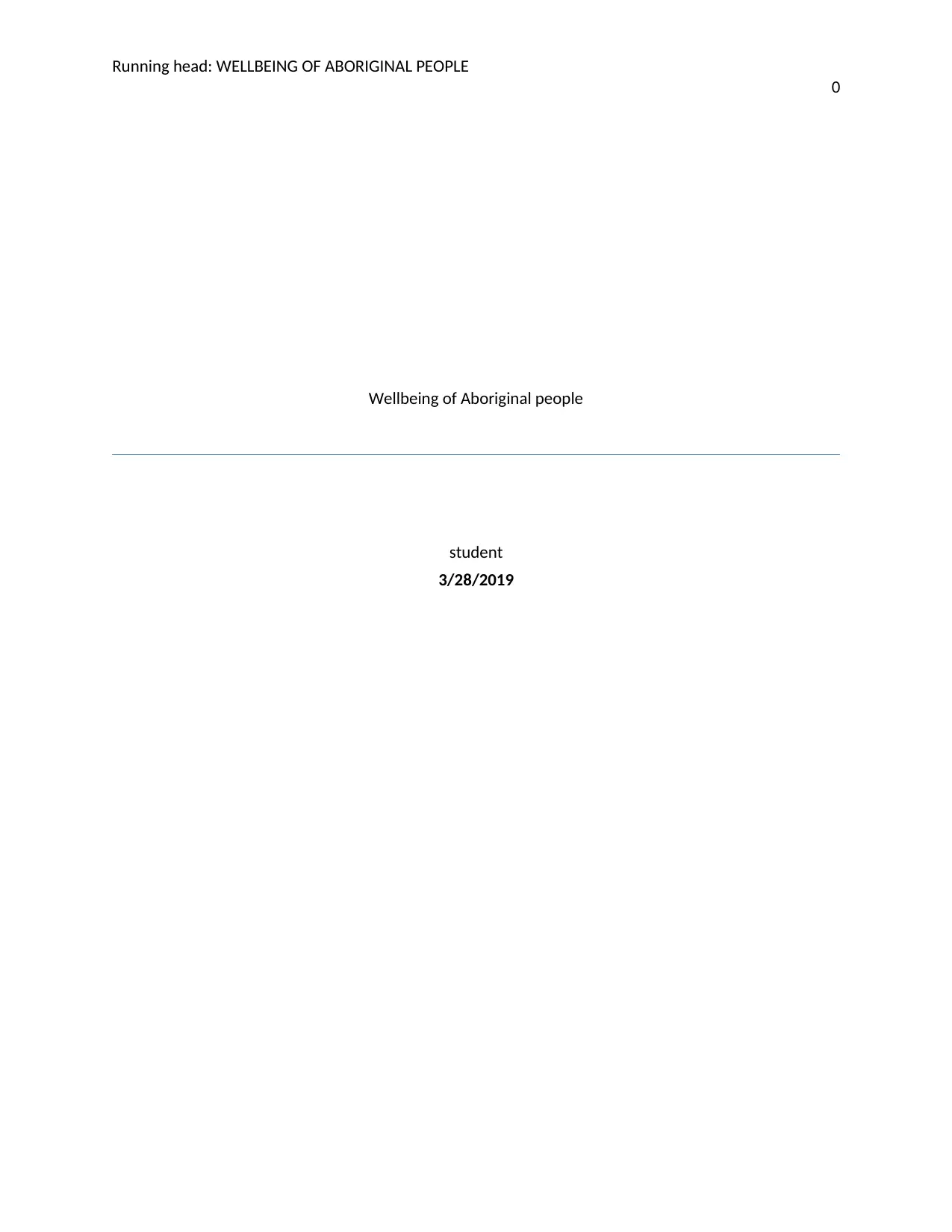
Running head: WELLBEING OF ABORIGINAL PEOPLE
0
Wellbeing of Aboriginal people
student
3/28/2019
0
Wellbeing of Aboriginal people
student
3/28/2019
Paraphrase This Document
Need a fresh take? Get an instant paraphrase of this document with our AI Paraphraser
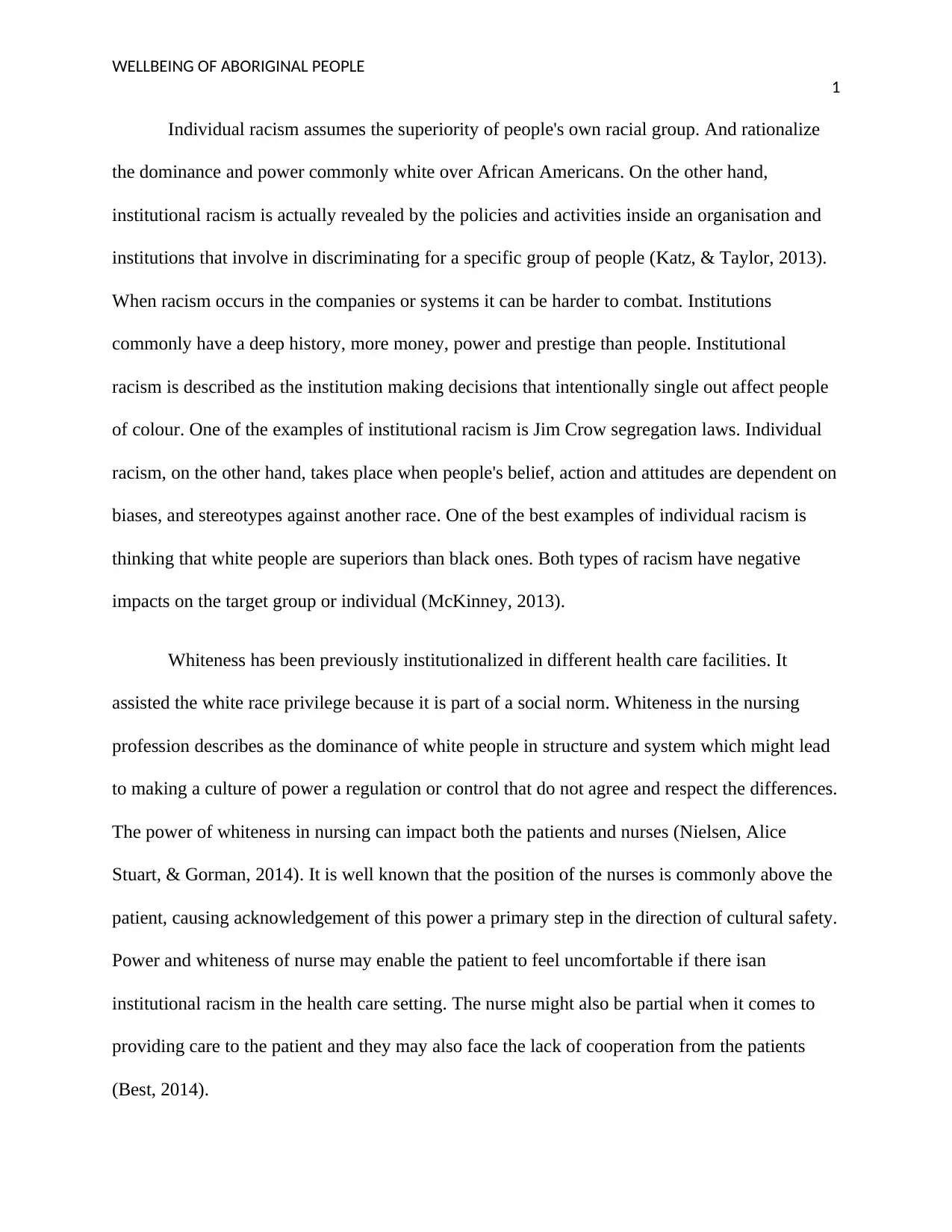
WELLBEING OF ABORIGINAL PEOPLE
1
Individual racism assumes the superiority of people's own racial group. And rationalize
the dominance and power commonly white over African Americans. On the other hand,
institutional racism is actually revealed by the policies and activities inside an organisation and
institutions that involve in discriminating for a specific group of people (Katz, & Taylor, 2013).
When racism occurs in the companies or systems it can be harder to combat. Institutions
commonly have a deep history, more money, power and prestige than people. Institutional
racism is described as the institution making decisions that intentionally single out affect people
of colour. One of the examples of institutional racism is Jim Crow segregation laws. Individual
racism, on the other hand, takes place when people's belief, action and attitudes are dependent on
biases, and stereotypes against another race. One of the best examples of individual racism is
thinking that white people are superiors than black ones. Both types of racism have negative
impacts on the target group or individual (McKinney, 2013).
Whiteness has been previously institutionalized in different health care facilities. It
assisted the white race privilege because it is part of a social norm. Whiteness in the nursing
profession describes as the dominance of white people in structure and system which might lead
to making a culture of power a regulation or control that do not agree and respect the differences.
The power of whiteness in nursing can impact both the patients and nurses (Nielsen, Alice
Stuart, & Gorman, 2014). It is well known that the position of the nurses is commonly above the
patient, causing acknowledgement of this power a primary step in the direction of cultural safety.
Power and whiteness of nurse may enable the patient to feel uncomfortable if there isan
institutional racism in the health care setting. The nurse might also be partial when it comes to
providing care to the patient and they may also face the lack of cooperation from the patients
(Best, 2014).
1
Individual racism assumes the superiority of people's own racial group. And rationalize
the dominance and power commonly white over African Americans. On the other hand,
institutional racism is actually revealed by the policies and activities inside an organisation and
institutions that involve in discriminating for a specific group of people (Katz, & Taylor, 2013).
When racism occurs in the companies or systems it can be harder to combat. Institutions
commonly have a deep history, more money, power and prestige than people. Institutional
racism is described as the institution making decisions that intentionally single out affect people
of colour. One of the examples of institutional racism is Jim Crow segregation laws. Individual
racism, on the other hand, takes place when people's belief, action and attitudes are dependent on
biases, and stereotypes against another race. One of the best examples of individual racism is
thinking that white people are superiors than black ones. Both types of racism have negative
impacts on the target group or individual (McKinney, 2013).
Whiteness has been previously institutionalized in different health care facilities. It
assisted the white race privilege because it is part of a social norm. Whiteness in the nursing
profession describes as the dominance of white people in structure and system which might lead
to making a culture of power a regulation or control that do not agree and respect the differences.
The power of whiteness in nursing can impact both the patients and nurses (Nielsen, Alice
Stuart, & Gorman, 2014). It is well known that the position of the nurses is commonly above the
patient, causing acknowledgement of this power a primary step in the direction of cultural safety.
Power and whiteness of nurse may enable the patient to feel uncomfortable if there isan
institutional racism in the health care setting. The nurse might also be partial when it comes to
providing care to the patient and they may also face the lack of cooperation from the patients
(Best, 2014).
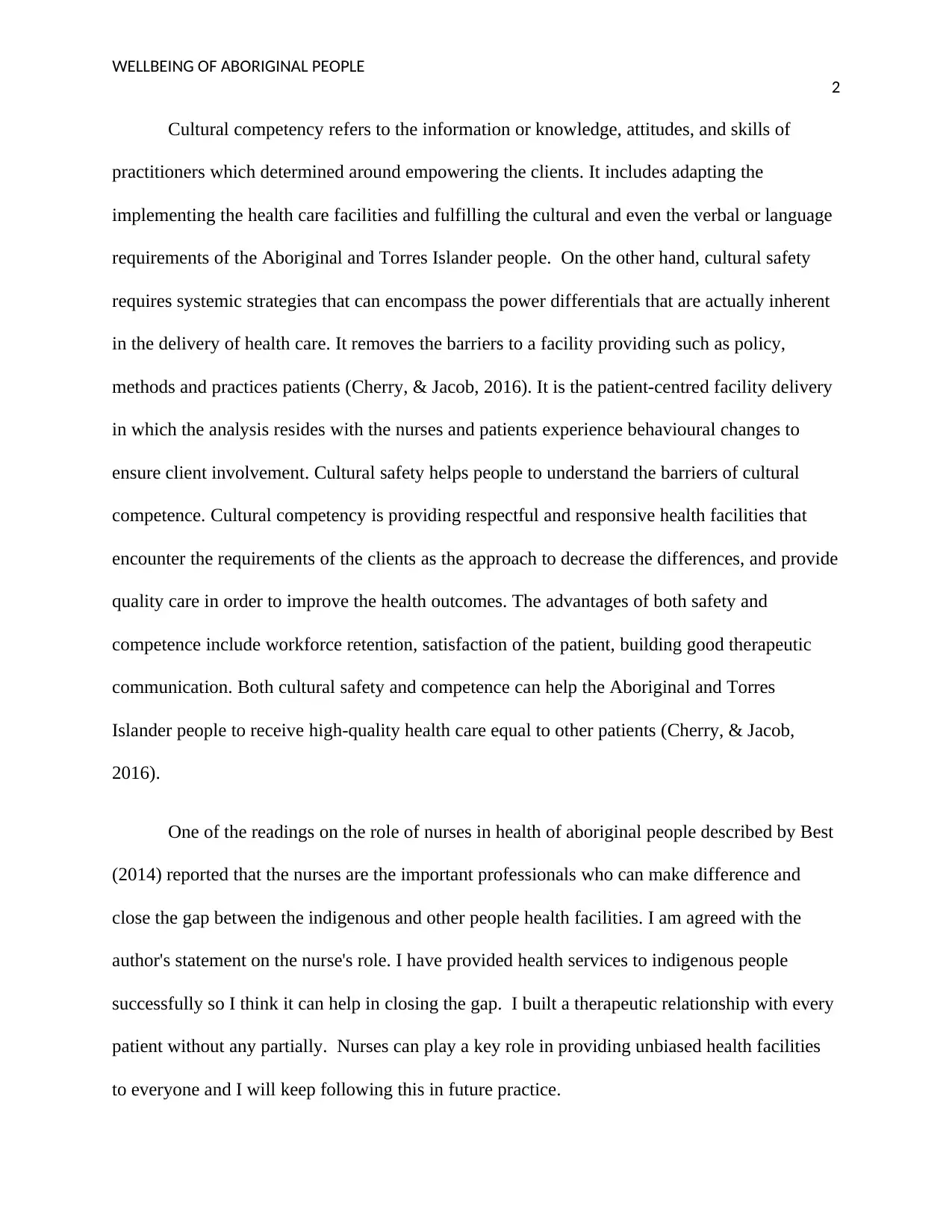
WELLBEING OF ABORIGINAL PEOPLE
2
Cultural competency refers to the information or knowledge, attitudes, and skills of
practitioners which determined around empowering the clients. It includes adapting the
implementing the health care facilities and fulfilling the cultural and even the verbal or language
requirements of the Aboriginal and Torres Islander people. On the other hand, cultural safety
requires systemic strategies that can encompass the power differentials that are actually inherent
in the delivery of health care. It removes the barriers to a facility providing such as policy,
methods and practices patients (Cherry, & Jacob, 2016). It is the patient-centred facility delivery
in which the analysis resides with the nurses and patients experience behavioural changes to
ensure client involvement. Cultural safety helps people to understand the barriers of cultural
competence. Cultural competency is providing respectful and responsive health facilities that
encounter the requirements of the clients as the approach to decrease the differences, and provide
quality care in order to improve the health outcomes. The advantages of both safety and
competence include workforce retention, satisfaction of the patient, building good therapeutic
communication. Both cultural safety and competence can help the Aboriginal and Torres
Islander people to receive high-quality health care equal to other patients (Cherry, & Jacob,
2016).
One of the readings on the role of nurses in health of aboriginal people described by Best
(2014) reported that the nurses are the important professionals who can make difference and
close the gap between the indigenous and other people health facilities. I am agreed with the
author's statement on the nurse's role. I have provided health services to indigenous people
successfully so I think it can help in closing the gap. I built a therapeutic relationship with every
patient without any partially. Nurses can play a key role in providing unbiased health facilities
to everyone and I will keep following this in future practice.
2
Cultural competency refers to the information or knowledge, attitudes, and skills of
practitioners which determined around empowering the clients. It includes adapting the
implementing the health care facilities and fulfilling the cultural and even the verbal or language
requirements of the Aboriginal and Torres Islander people. On the other hand, cultural safety
requires systemic strategies that can encompass the power differentials that are actually inherent
in the delivery of health care. It removes the barriers to a facility providing such as policy,
methods and practices patients (Cherry, & Jacob, 2016). It is the patient-centred facility delivery
in which the analysis resides with the nurses and patients experience behavioural changes to
ensure client involvement. Cultural safety helps people to understand the barriers of cultural
competence. Cultural competency is providing respectful and responsive health facilities that
encounter the requirements of the clients as the approach to decrease the differences, and provide
quality care in order to improve the health outcomes. The advantages of both safety and
competence include workforce retention, satisfaction of the patient, building good therapeutic
communication. Both cultural safety and competence can help the Aboriginal and Torres
Islander people to receive high-quality health care equal to other patients (Cherry, & Jacob,
2016).
One of the readings on the role of nurses in health of aboriginal people described by Best
(2014) reported that the nurses are the important professionals who can make difference and
close the gap between the indigenous and other people health facilities. I am agreed with the
author's statement on the nurse's role. I have provided health services to indigenous people
successfully so I think it can help in closing the gap. I built a therapeutic relationship with every
patient without any partially. Nurses can play a key role in providing unbiased health facilities
to everyone and I will keep following this in future practice.
⊘ This is a preview!⊘
Do you want full access?
Subscribe today to unlock all pages.

Trusted by 1+ million students worldwide
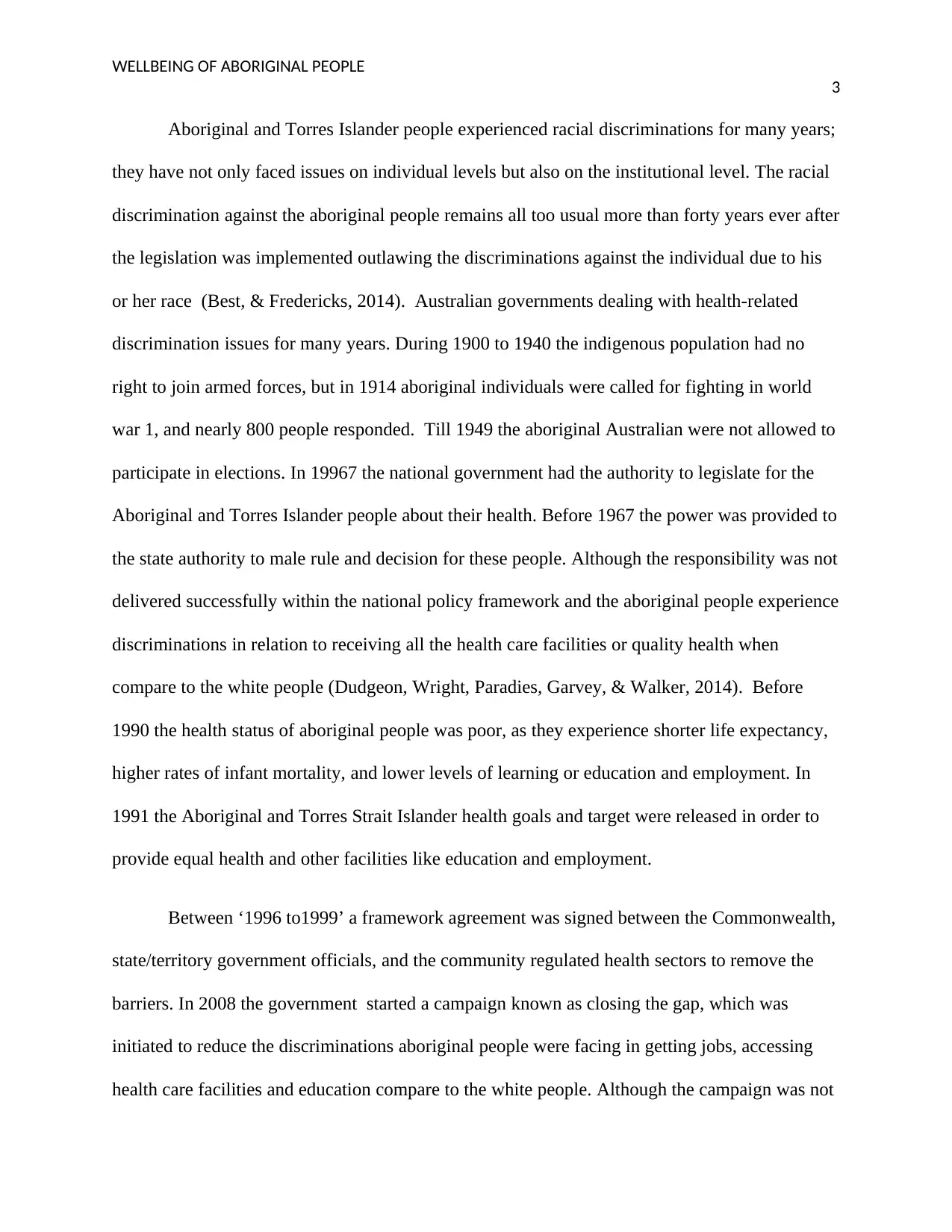
WELLBEING OF ABORIGINAL PEOPLE
3
Aboriginal and Torres Islander people experienced racial discriminations for many years;
they have not only faced issues on individual levels but also on the institutional level. The racial
discrimination against the aboriginal people remains all too usual more than forty years ever after
the legislation was implemented outlawing the discriminations against the individual due to his
or her race (Best, & Fredericks, 2014). Australian governments dealing with health-related
discrimination issues for many years. During 1900 to 1940 the indigenous population had no
right to join armed forces, but in 1914 aboriginal individuals were called for fighting in world
war 1, and nearly 800 people responded. Till 1949 the aboriginal Australian were not allowed to
participate in elections. In 19967 the national government had the authority to legislate for the
Aboriginal and Torres Islander people about their health. Before 1967 the power was provided to
the state authority to male rule and decision for these people. Although the responsibility was not
delivered successfully within the national policy framework and the aboriginal people experience
discriminations in relation to receiving all the health care facilities or quality health when
compare to the white people (Dudgeon, Wright, Paradies, Garvey, & Walker, 2014). Before
1990 the health status of aboriginal people was poor, as they experience shorter life expectancy,
higher rates of infant mortality, and lower levels of learning or education and employment. In
1991 the Aboriginal and Torres Strait Islander health goals and target were released in order to
provide equal health and other facilities like education and employment.
Between ‘1996 to1999’ a framework agreement was signed between the Commonwealth,
state/territory government officials, and the community regulated health sectors to remove the
barriers. In 2008 the government started a campaign known as closing the gap, which was
initiated to reduce the discriminations aboriginal people were facing in getting jobs, accessing
health care facilities and education compare to the white people. Although the campaign was not
3
Aboriginal and Torres Islander people experienced racial discriminations for many years;
they have not only faced issues on individual levels but also on the institutional level. The racial
discrimination against the aboriginal people remains all too usual more than forty years ever after
the legislation was implemented outlawing the discriminations against the individual due to his
or her race (Best, & Fredericks, 2014). Australian governments dealing with health-related
discrimination issues for many years. During 1900 to 1940 the indigenous population had no
right to join armed forces, but in 1914 aboriginal individuals were called for fighting in world
war 1, and nearly 800 people responded. Till 1949 the aboriginal Australian were not allowed to
participate in elections. In 19967 the national government had the authority to legislate for the
Aboriginal and Torres Islander people about their health. Before 1967 the power was provided to
the state authority to male rule and decision for these people. Although the responsibility was not
delivered successfully within the national policy framework and the aboriginal people experience
discriminations in relation to receiving all the health care facilities or quality health when
compare to the white people (Dudgeon, Wright, Paradies, Garvey, & Walker, 2014). Before
1990 the health status of aboriginal people was poor, as they experience shorter life expectancy,
higher rates of infant mortality, and lower levels of learning or education and employment. In
1991 the Aboriginal and Torres Strait Islander health goals and target were released in order to
provide equal health and other facilities like education and employment.
Between ‘1996 to1999’ a framework agreement was signed between the Commonwealth,
state/territory government officials, and the community regulated health sectors to remove the
barriers. In 2008 the government started a campaign known as closing the gap, which was
initiated to reduce the discriminations aboriginal people were facing in getting jobs, accessing
health care facilities and education compare to the white people. Although the campaign was not
Paraphrase This Document
Need a fresh take? Get an instant paraphrase of this document with our AI Paraphraser
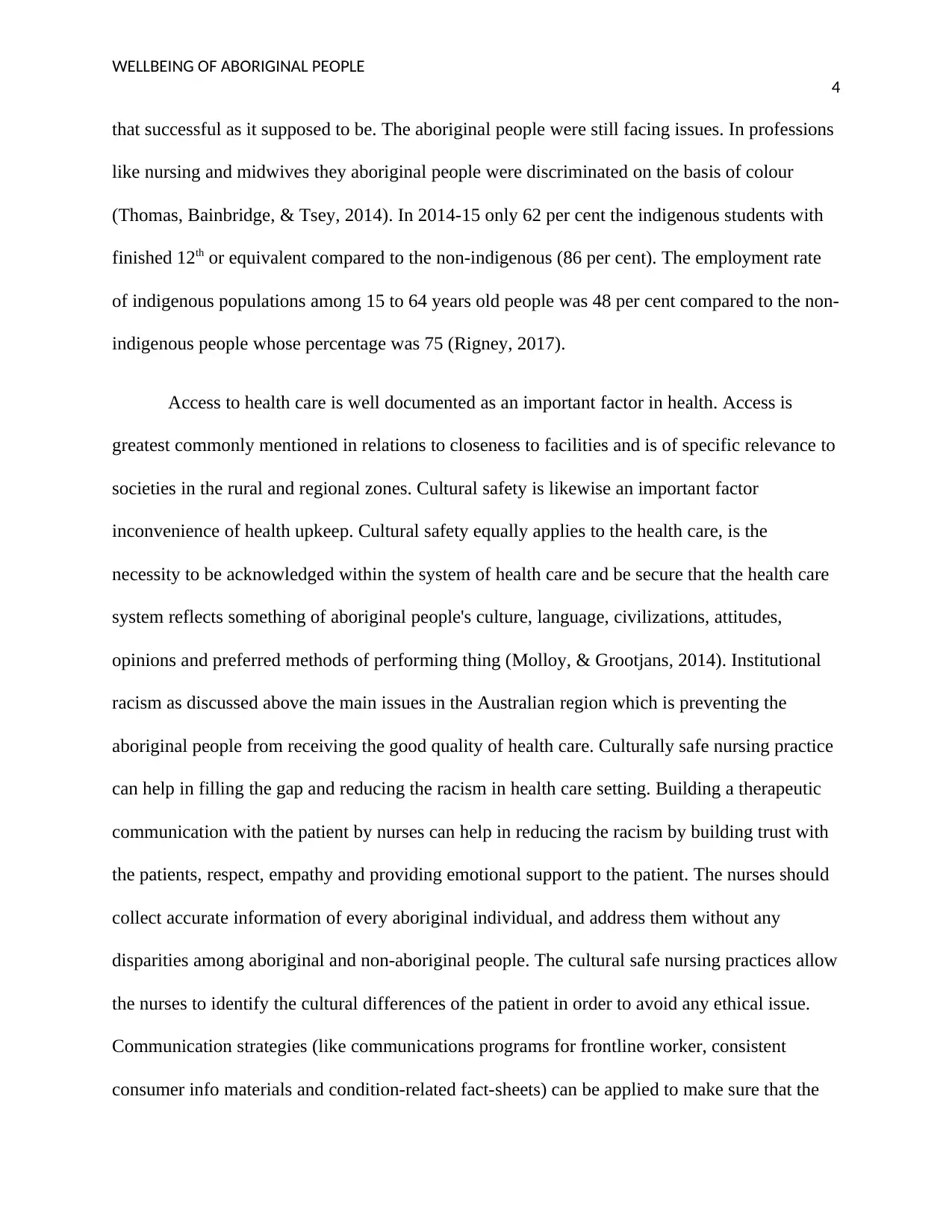
WELLBEING OF ABORIGINAL PEOPLE
4
that successful as it supposed to be. The aboriginal people were still facing issues. In professions
like nursing and midwives they aboriginal people were discriminated on the basis of colour
(Thomas, Bainbridge, & Tsey, 2014). In 2014-15 only 62 per cent the indigenous students with
finished 12th or equivalent compared to the non-indigenous (86 per cent). The employment rate
of indigenous populations among 15 to 64 years old people was 48 per cent compared to the non-
indigenous people whose percentage was 75 (Rigney, 2017).
Access to health care is well documented as an important factor in health. Access is
greatest commonly mentioned in relations to closeness to facilities and is of specific relevance to
societies in the rural and regional zones. Cultural safety is likewise an important factor
inconvenience of health upkeep. Cultural safety equally applies to the health care, is the
necessity to be acknowledged within the system of health care and be secure that the health care
system reflects something of aboriginal people's culture, language, civilizations, attitudes,
opinions and preferred methods of performing thing (Molloy, & Grootjans, 2014). Institutional
racism as discussed above the main issues in the Australian region which is preventing the
aboriginal people from receiving the good quality of health care. Culturally safe nursing practice
can help in filling the gap and reducing the racism in health care setting. Building a therapeutic
communication with the patient by nurses can help in reducing the racism by building trust with
the patients, respect, empathy and providing emotional support to the patient. The nurses should
collect accurate information of every aboriginal individual, and address them without any
disparities among aboriginal and non-aboriginal people. The cultural safe nursing practices allow
the nurses to identify the cultural differences of the patient in order to avoid any ethical issue.
Communication strategies (like communications programs for frontline worker, consistent
consumer info materials and condition-related fact-sheets) can be applied to make sure that the
4
that successful as it supposed to be. The aboriginal people were still facing issues. In professions
like nursing and midwives they aboriginal people were discriminated on the basis of colour
(Thomas, Bainbridge, & Tsey, 2014). In 2014-15 only 62 per cent the indigenous students with
finished 12th or equivalent compared to the non-indigenous (86 per cent). The employment rate
of indigenous populations among 15 to 64 years old people was 48 per cent compared to the non-
indigenous people whose percentage was 75 (Rigney, 2017).
Access to health care is well documented as an important factor in health. Access is
greatest commonly mentioned in relations to closeness to facilities and is of specific relevance to
societies in the rural and regional zones. Cultural safety is likewise an important factor
inconvenience of health upkeep. Cultural safety equally applies to the health care, is the
necessity to be acknowledged within the system of health care and be secure that the health care
system reflects something of aboriginal people's culture, language, civilizations, attitudes,
opinions and preferred methods of performing thing (Molloy, & Grootjans, 2014). Institutional
racism as discussed above the main issues in the Australian region which is preventing the
aboriginal people from receiving the good quality of health care. Culturally safe nursing practice
can help in filling the gap and reducing the racism in health care setting. Building a therapeutic
communication with the patient by nurses can help in reducing the racism by building trust with
the patients, respect, empathy and providing emotional support to the patient. The nurses should
collect accurate information of every aboriginal individual, and address them without any
disparities among aboriginal and non-aboriginal people. The cultural safe nursing practices allow
the nurses to identify the cultural differences of the patient in order to avoid any ethical issue.
Communication strategies (like communications programs for frontline worker, consistent
consumer info materials and condition-related fact-sheets) can be applied to make sure that the
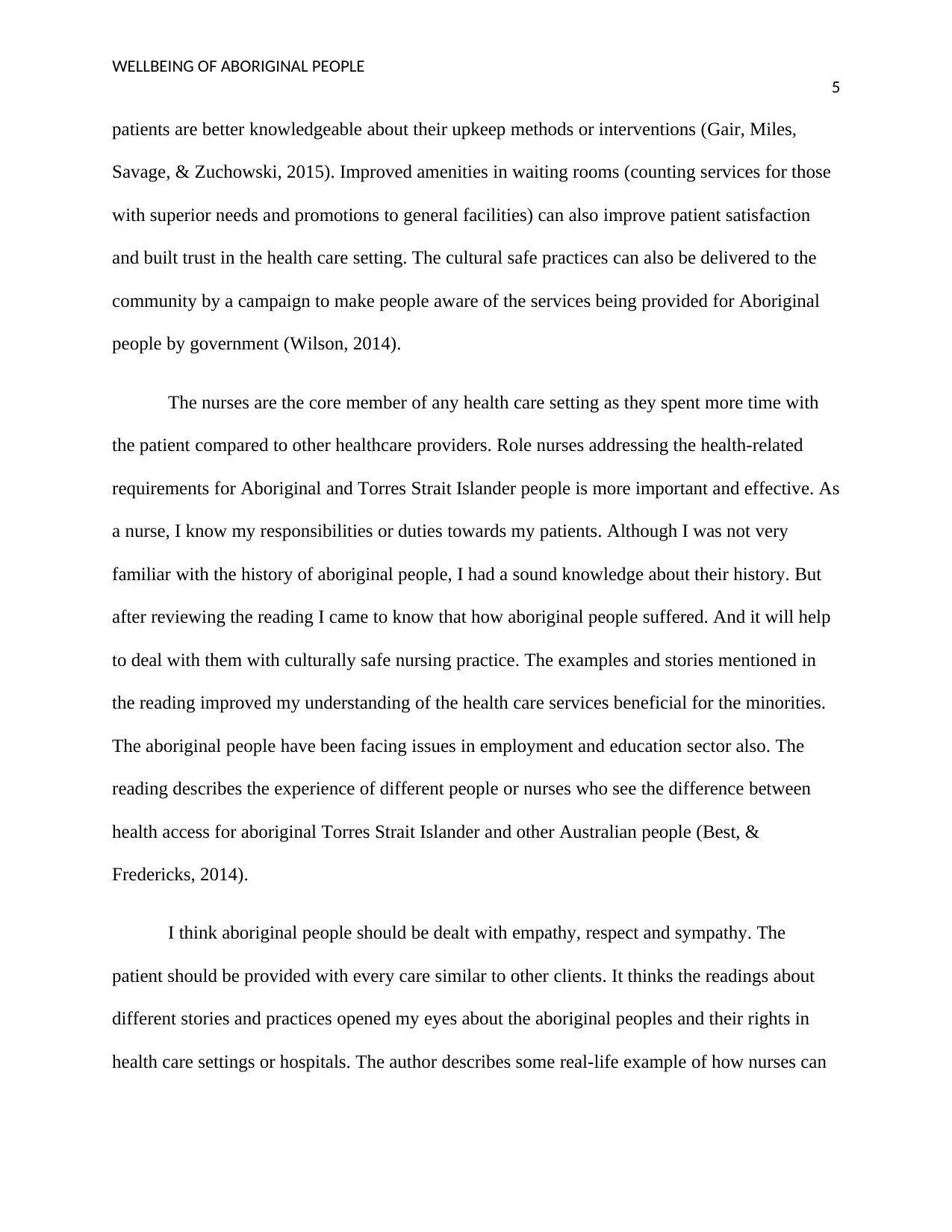
WELLBEING OF ABORIGINAL PEOPLE
5
patients are better knowledgeable about their upkeep methods or interventions (Gair, Miles,
Savage, & Zuchowski, 2015). Improved amenities in waiting rooms (counting services for those
with superior needs and promotions to general facilities) can also improve patient satisfaction
and built trust in the health care setting. The cultural safe practices can also be delivered to the
community by a campaign to make people aware of the services being provided for Aboriginal
people by government (Wilson, 2014).
The nurses are the core member of any health care setting as they spent more time with
the patient compared to other healthcare providers. Role nurses addressing the health-related
requirements for Aboriginal and Torres Strait Islander people is more important and effective. As
a nurse, I know my responsibilities or duties towards my patients. Although I was not very
familiar with the history of aboriginal people, I had a sound knowledge about their history. But
after reviewing the reading I came to know that how aboriginal people suffered. And it will help
to deal with them with culturally safe nursing practice. The examples and stories mentioned in
the reading improved my understanding of the health care services beneficial for the minorities.
The aboriginal people have been facing issues in employment and education sector also. The
reading describes the experience of different people or nurses who see the difference between
health access for aboriginal Torres Strait Islander and other Australian people (Best, &
Fredericks, 2014).
I think aboriginal people should be dealt with empathy, respect and sympathy. The
patient should be provided with every care similar to other clients. It thinks the readings about
different stories and practices opened my eyes about the aboriginal peoples and their rights in
health care settings or hospitals. The author describes some real-life example of how nurses can
5
patients are better knowledgeable about their upkeep methods or interventions (Gair, Miles,
Savage, & Zuchowski, 2015). Improved amenities in waiting rooms (counting services for those
with superior needs and promotions to general facilities) can also improve patient satisfaction
and built trust in the health care setting. The cultural safe practices can also be delivered to the
community by a campaign to make people aware of the services being provided for Aboriginal
people by government (Wilson, 2014).
The nurses are the core member of any health care setting as they spent more time with
the patient compared to other healthcare providers. Role nurses addressing the health-related
requirements for Aboriginal and Torres Strait Islander people is more important and effective. As
a nurse, I know my responsibilities or duties towards my patients. Although I was not very
familiar with the history of aboriginal people, I had a sound knowledge about their history. But
after reviewing the reading I came to know that how aboriginal people suffered. And it will help
to deal with them with culturally safe nursing practice. The examples and stories mentioned in
the reading improved my understanding of the health care services beneficial for the minorities.
The aboriginal people have been facing issues in employment and education sector also. The
reading describes the experience of different people or nurses who see the difference between
health access for aboriginal Torres Strait Islander and other Australian people (Best, &
Fredericks, 2014).
I think aboriginal people should be dealt with empathy, respect and sympathy. The
patient should be provided with every care similar to other clients. It thinks the readings about
different stories and practices opened my eyes about the aboriginal peoples and their rights in
health care settings or hospitals. The author describes some real-life example of how nurses can
⊘ This is a preview!⊘
Do you want full access?
Subscribe today to unlock all pages.

Trusted by 1+ million students worldwide
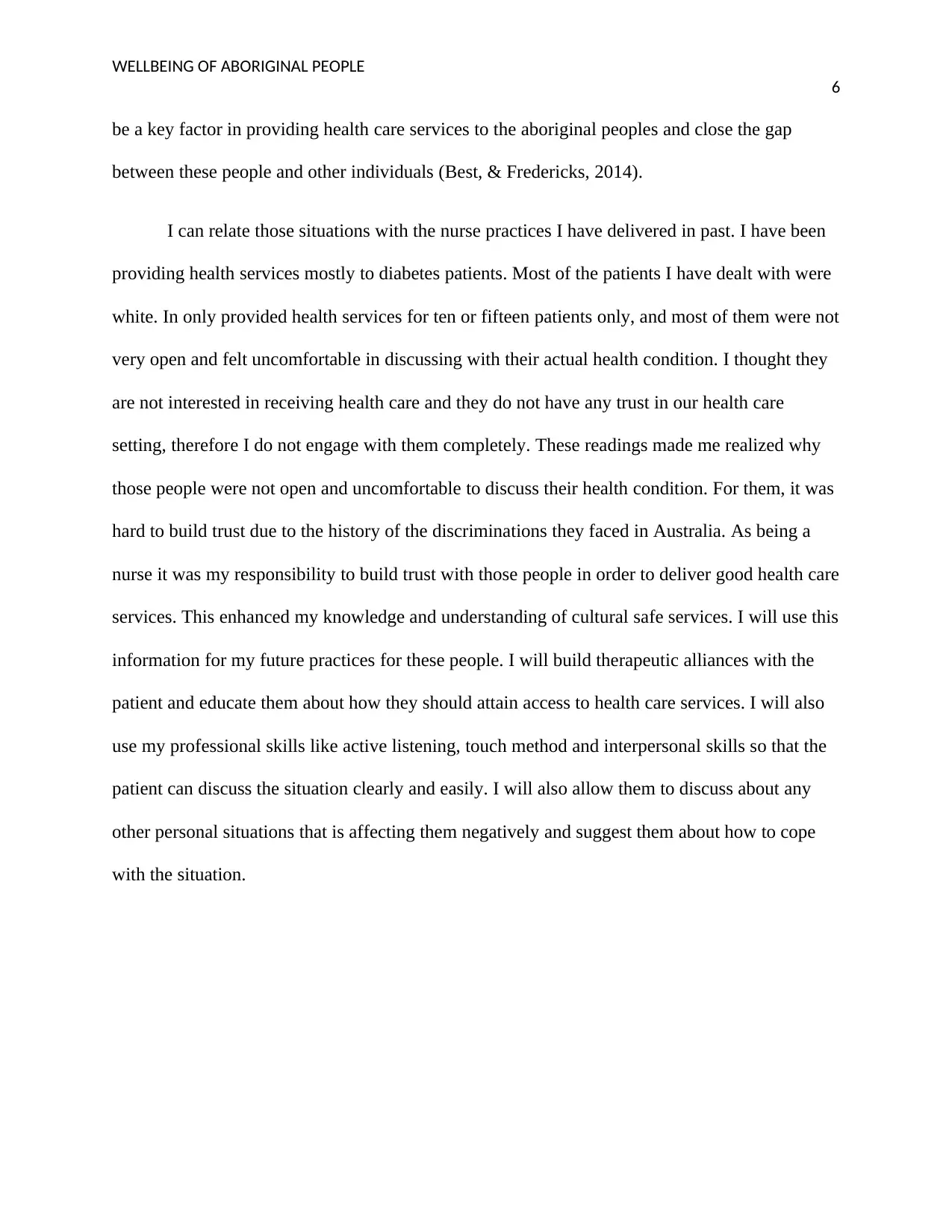
WELLBEING OF ABORIGINAL PEOPLE
6
be a key factor in providing health care services to the aboriginal peoples and close the gap
between these people and other individuals (Best, & Fredericks, 2014).
I can relate those situations with the nurse practices I have delivered in past. I have been
providing health services mostly to diabetes patients. Most of the patients I have dealt with were
white. In only provided health services for ten or fifteen patients only, and most of them were not
very open and felt uncomfortable in discussing with their actual health condition. I thought they
are not interested in receiving health care and they do not have any trust in our health care
setting, therefore I do not engage with them completely. These readings made me realized why
those people were not open and uncomfortable to discuss their health condition. For them, it was
hard to build trust due to the history of the discriminations they faced in Australia. As being a
nurse it was my responsibility to build trust with those people in order to deliver good health care
services. This enhanced my knowledge and understanding of cultural safe services. I will use this
information for my future practices for these people. I will build therapeutic alliances with the
patient and educate them about how they should attain access to health care services. I will also
use my professional skills like active listening, touch method and interpersonal skills so that the
patient can discuss the situation clearly and easily. I will also allow them to discuss about any
other personal situations that is affecting them negatively and suggest them about how to cope
with the situation.
6
be a key factor in providing health care services to the aboriginal peoples and close the gap
between these people and other individuals (Best, & Fredericks, 2014).
I can relate those situations with the nurse practices I have delivered in past. I have been
providing health services mostly to diabetes patients. Most of the patients I have dealt with were
white. In only provided health services for ten or fifteen patients only, and most of them were not
very open and felt uncomfortable in discussing with their actual health condition. I thought they
are not interested in receiving health care and they do not have any trust in our health care
setting, therefore I do not engage with them completely. These readings made me realized why
those people were not open and uncomfortable to discuss their health condition. For them, it was
hard to build trust due to the history of the discriminations they faced in Australia. As being a
nurse it was my responsibility to build trust with those people in order to deliver good health care
services. This enhanced my knowledge and understanding of cultural safe services. I will use this
information for my future practices for these people. I will build therapeutic alliances with the
patient and educate them about how they should attain access to health care services. I will also
use my professional skills like active listening, touch method and interpersonal skills so that the
patient can discuss the situation clearly and easily. I will also allow them to discuss about any
other personal situations that is affecting them negatively and suggest them about how to cope
with the situation.
Paraphrase This Document
Need a fresh take? Get an instant paraphrase of this document with our AI Paraphraser
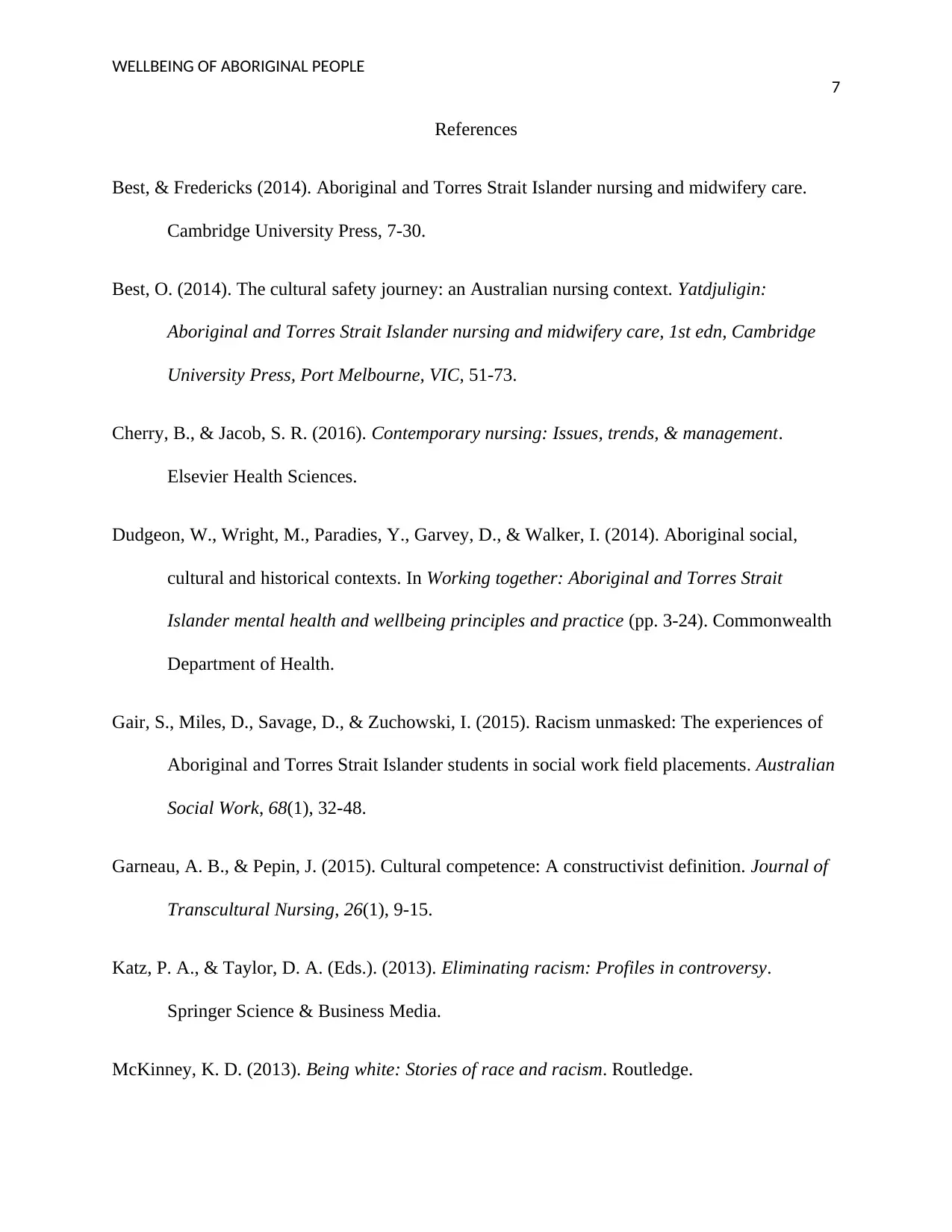
WELLBEING OF ABORIGINAL PEOPLE
7
References
Best, & Fredericks (2014). Aboriginal and Torres Strait Islander nursing and midwifery care.
Cambridge University Press, 7-30.
Best, O. (2014). The cultural safety journey: an Australian nursing context. Yatdjuligin:
Aboriginal and Torres Strait Islander nursing and midwifery care, 1st edn, Cambridge
University Press, Port Melbourne, VIC, 51-73.
Cherry, B., & Jacob, S. R. (2016). Contemporary nursing: Issues, trends, & management.
Elsevier Health Sciences.
Dudgeon, W., Wright, M., Paradies, Y., Garvey, D., & Walker, I. (2014). Aboriginal social,
cultural and historical contexts. In Working together: Aboriginal and Torres Strait
Islander mental health and wellbeing principles and practice (pp. 3-24). Commonwealth
Department of Health.
Gair, S., Miles, D., Savage, D., & Zuchowski, I. (2015). Racism unmasked: The experiences of
Aboriginal and Torres Strait Islander students in social work field placements. Australian
Social Work, 68(1), 32-48.
Garneau, A. B., & Pepin, J. (2015). Cultural competence: A constructivist definition. Journal of
Transcultural Nursing, 26(1), 9-15.
Katz, P. A., & Taylor, D. A. (Eds.). (2013). Eliminating racism: Profiles in controversy.
Springer Science & Business Media.
McKinney, K. D. (2013). Being white: Stories of race and racism. Routledge.
7
References
Best, & Fredericks (2014). Aboriginal and Torres Strait Islander nursing and midwifery care.
Cambridge University Press, 7-30.
Best, O. (2014). The cultural safety journey: an Australian nursing context. Yatdjuligin:
Aboriginal and Torres Strait Islander nursing and midwifery care, 1st edn, Cambridge
University Press, Port Melbourne, VIC, 51-73.
Cherry, B., & Jacob, S. R. (2016). Contemporary nursing: Issues, trends, & management.
Elsevier Health Sciences.
Dudgeon, W., Wright, M., Paradies, Y., Garvey, D., & Walker, I. (2014). Aboriginal social,
cultural and historical contexts. In Working together: Aboriginal and Torres Strait
Islander mental health and wellbeing principles and practice (pp. 3-24). Commonwealth
Department of Health.
Gair, S., Miles, D., Savage, D., & Zuchowski, I. (2015). Racism unmasked: The experiences of
Aboriginal and Torres Strait Islander students in social work field placements. Australian
Social Work, 68(1), 32-48.
Garneau, A. B., & Pepin, J. (2015). Cultural competence: A constructivist definition. Journal of
Transcultural Nursing, 26(1), 9-15.
Katz, P. A., & Taylor, D. A. (Eds.). (2013). Eliminating racism: Profiles in controversy.
Springer Science & Business Media.
McKinney, K. D. (2013). Being white: Stories of race and racism. Routledge.
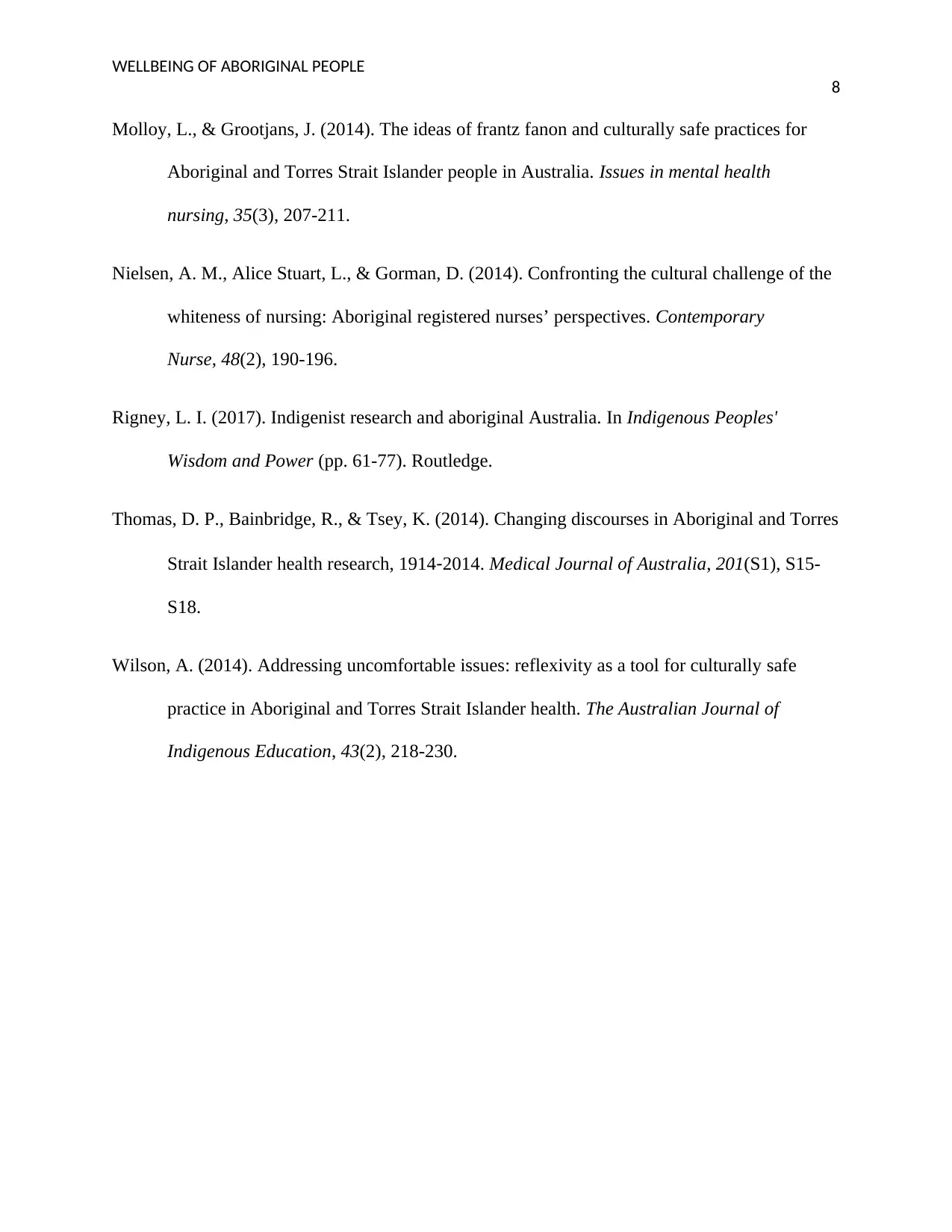
WELLBEING OF ABORIGINAL PEOPLE
8
Molloy, L., & Grootjans, J. (2014). The ideas of frantz fanon and culturally safe practices for
Aboriginal and Torres Strait Islander people in Australia. Issues in mental health
nursing, 35(3), 207-211.
Nielsen, A. M., Alice Stuart, L., & Gorman, D. (2014). Confronting the cultural challenge of the
whiteness of nursing: Aboriginal registered nurses’ perspectives. Contemporary
Nurse, 48(2), 190-196.
Rigney, L. I. (2017). Indigenist research and aboriginal Australia. In Indigenous Peoples'
Wisdom and Power (pp. 61-77). Routledge.
Thomas, D. P., Bainbridge, R., & Tsey, K. (2014). Changing discourses in Aboriginal and Torres
Strait Islander health research, 1914‐2014. Medical Journal of Australia, 201(S1), S15-
S18.
Wilson, A. (2014). Addressing uncomfortable issues: reflexivity as a tool for culturally safe
practice in Aboriginal and Torres Strait Islander health. The Australian Journal of
Indigenous Education, 43(2), 218-230.
8
Molloy, L., & Grootjans, J. (2014). The ideas of frantz fanon and culturally safe practices for
Aboriginal and Torres Strait Islander people in Australia. Issues in mental health
nursing, 35(3), 207-211.
Nielsen, A. M., Alice Stuart, L., & Gorman, D. (2014). Confronting the cultural challenge of the
whiteness of nursing: Aboriginal registered nurses’ perspectives. Contemporary
Nurse, 48(2), 190-196.
Rigney, L. I. (2017). Indigenist research and aboriginal Australia. In Indigenous Peoples'
Wisdom and Power (pp. 61-77). Routledge.
Thomas, D. P., Bainbridge, R., & Tsey, K. (2014). Changing discourses in Aboriginal and Torres
Strait Islander health research, 1914‐2014. Medical Journal of Australia, 201(S1), S15-
S18.
Wilson, A. (2014). Addressing uncomfortable issues: reflexivity as a tool for culturally safe
practice in Aboriginal and Torres Strait Islander health. The Australian Journal of
Indigenous Education, 43(2), 218-230.
⊘ This is a preview!⊘
Do you want full access?
Subscribe today to unlock all pages.

Trusted by 1+ million students worldwide
1 out of 9
Related Documents
Your All-in-One AI-Powered Toolkit for Academic Success.
+13062052269
info@desklib.com
Available 24*7 on WhatsApp / Email
![[object Object]](/_next/static/media/star-bottom.7253800d.svg)
Unlock your academic potential
Copyright © 2020–2025 A2Z Services. All Rights Reserved. Developed and managed by ZUCOL.




